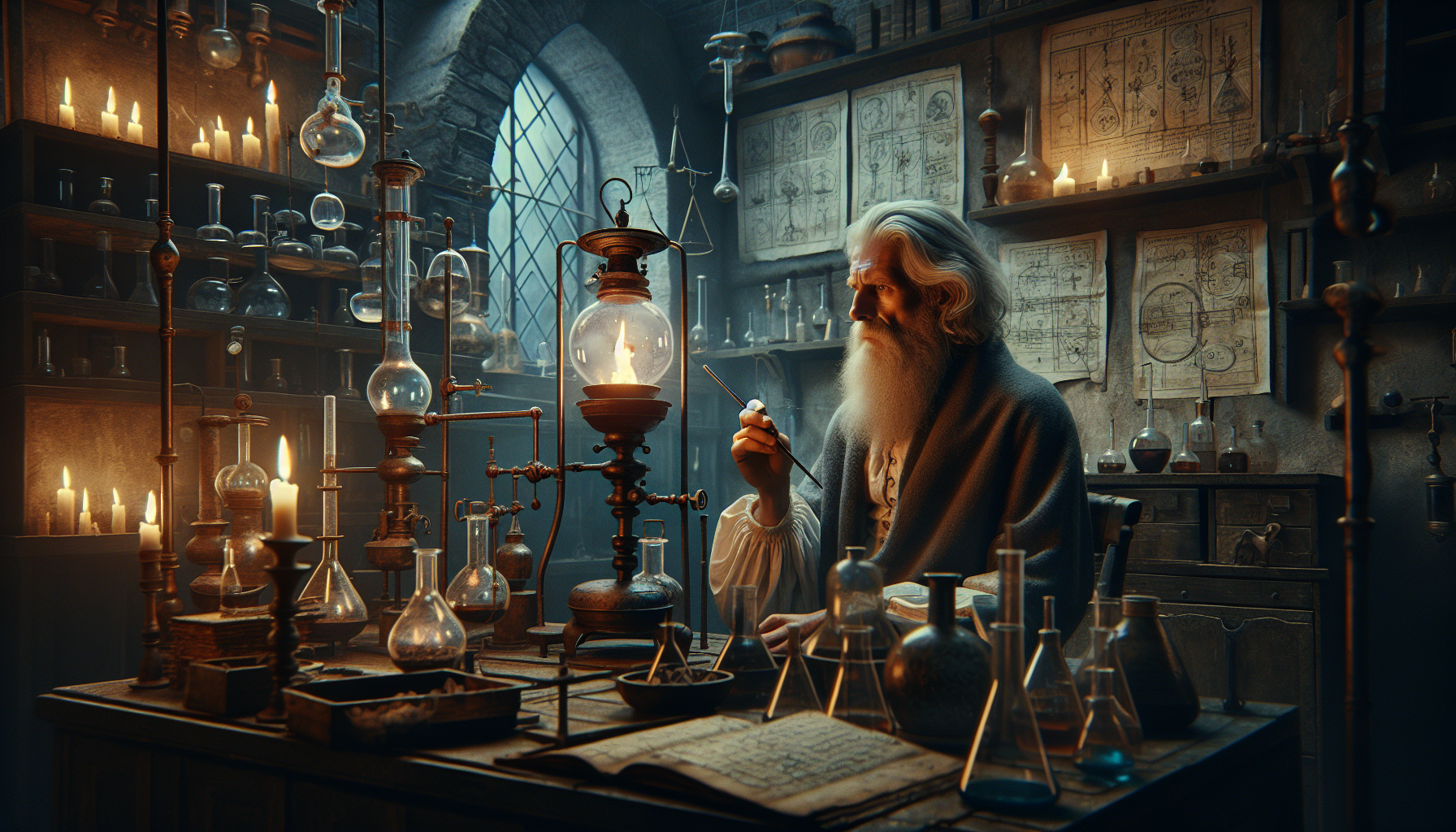In the quiet whispers of history, amid the pages of ancient scientific endeavors, lies a theory that once set the world of chemistry ablaze with curiosity and debate: the Phlogiston Theory. As we embark on this journey through time, we will unravel the enigma of this long-discarded concept, exploring its intriguing origins and the remarkable impact it had on the study of combustion. Picture a world where the mysteries of fire were still largely unsolved, where alchemists and early scientists sought to unlock the secrets hidden within the flickering flames. It was in this era of discovery that the Phlogiston Theory emerged, offering a lens through which the natural phenomena of burning could be understood—or so it seemed. 🔥
The Phlogiston Theory, proposed in the late 17th century, suggested that a mysterious element called “phlogiston” was released during combustion. This hypothetical substance was thought to reside within all flammable materials, and its release was believed to be responsible for the process of burning. Imagine a time when the boundaries between science and philosophy were blurred, when learned individuals gathered in dimly lit rooms, exchanging radical ideas and challenging the status quo. It was a time when the Phlogiston Theory captured the imagination of some of the greatest minds of the Enlightenment, sparking both controversy and inspiration.
In this exploration, we will delve into the fascinating history of the Phlogiston Theory, tracing its origins to the pioneering work of Johann Joachim Becher and Georg Ernst Stahl. We will examine how this theory, despite its eventual downfall, played a crucial role in shaping the scientific method and the development of modern chemistry. Our journey will also take us through the dramatic shift in scientific thinking that led to the ultimate rejection of phlogiston, giving way to the oxygen theory of combustion proposed by Antoine Lavoisier. We will discover how this paradigm shift not only advanced our understanding of chemical reactions but also laid the groundwork for the future of scientific inquiry.
Join us as we uncover the layers of mystery surrounding the Phlogiston Theory, dissecting its influence on the scientific community of its time and its lasting legacy in the history of science. Through this narrative, we aim to shed light on the process of scientific evolution—a tale of trial, error, and enlightenment. As we navigate the intricacies of this once-revolutionary concept, we invite you to ponder the nature of scientific progress and the profound impact that even the most flawed theories can have on the advancement of human knowledge. 🌟
The Origins of the Phlogiston Theory
The Phlogiston Theory, a historical concept in the development of chemistry, emerged in the late 17th century as a way to explain combustion and oxidation processes. This theory was proposed by German alchemist and physician Johann Joachim Becher in 1667 and later developed by his student Georg Ernst Stahl. The theory posited that all combustible materials contained a substance called “phlogiston” which was released during burning. The remaining material, known as the “calx,” was thought to be the true form of the substance once it had lost its phlogiston.
Becher and Stahl’s theory was largely influenced by the scientific context of their time. Alchemy, with its mystical and philosophical underpinnings, was the precursor to modern chemistry and sought to explain natural phenomena through a lens that blended empirical observation with spiritual and elemental principles. The Phlogiston Theory was an attempt to provide a more systematic explanation for the combustion process than those offered by earlier alchemical practices, which often lacked empirical grounding.
While the theory was appealing to many scientists of the time, it faced significant challenges and inconsistencies. For instance, the theory struggled to explain why metals gained weight after being burned, which contradicted the notion that phlogiston was a weightless entity. Despite its flaws, the theory gained traction and was widely accepted until the late 18th century when it was eventually supplanted by the work of Antoine Lavoisier and the rise of modern chemistry.
Key Principles of the Phlogiston Theory
The Phlogiston Theory was grounded in several core principles that defined its understanding of combustion and oxidation:
- Combustible Substances: According to the theory, all combustible materials contain phlogiston, which is released during combustion.
- Role of Calx: After combustion, the remaining material, referred to as “calx,” was believed to be the original substance devoid of phlogiston.
- Weight Paradox: The theory posited that phlogiston was a massless substance, which led to challenges in explaining why some substances appeared to gain weight post-combustion.
The Rise and Fall of the Phlogiston Theory
The Phlogiston Theory remained dominant for nearly a century, shaping scientific understanding and experimentation with combustible materials. During this time, many renowned scientists, including Joseph Priestley and Carl Wilhelm Scheele, conducted experiments within the framework of phlogiston. Priestley, for example, isolated “dephlogisticated air” (what we now know as oxygen), believing it to be air devoid of phlogiston.
Despite its widespread acceptance, the theory’s limitations became increasingly apparent. One of the major challenges was its inability to account for the weight increase observed in metals after combustion. This discrepancy was noted by several scientists, including Antoine Lavoisier, who conducted meticulous experiments to test the theory’s validity. Lavoisier’s work led to the discovery of oxygen’s role in combustion, ultimately discrediting the Phlogiston Theory and paving the way for the chemical revolution.
Lavoisier’s introduction of a new chemical framework, based on the conservation of mass and the role of oxygen in combustion, provided a more accurate and comprehensive understanding of these processes. His work marked a significant turning point in the history of chemistry, transitioning from alchemical traditions to a more empirical and systematic scientific approach.
Comparison with Modern Chemistry
To better understand the impact of the Phlogiston Theory, it is helpful to compare its principles with those of modern chemistry. Below is a comparative table highlighting key differences:
| Aspect | Phlogiston Theory | Modern Chemistry |
|---|---|---|
| Explanation of Combustion | Release of phlogiston | Reaction with oxygen |
| Nature of Substance | Depleted of phlogiston | Composed of elements and compounds |
| Weight Changes | Inconsistently explained | Conservation of mass |
The Legacy of the Phlogiston Theory
Despite its eventual replacement, the Phlogiston Theory played a crucial role in the development of chemistry as a science. Its impact is evident in the way it shaped experimental approaches and encouraged scientists to seek systematic explanations for natural phenomena. The theory’s historical significance lies in its ability to bridge the gap between alchemical traditions and modern scientific inquiry.
The process of scientific advancement is often marked by the proposal and refinement of theories, and the Phlogiston Theory is a prime example of this dynamic. It prompted rigorous experimentation and debate, which ultimately led to the discovery of oxygen and the establishment of modern chemical principles. This progression underscores the importance of questioning established theories and pursuing new lines of inquiry to advance scientific knowledge.
Today, the Phlogiston Theory is often cited as a case study in the history of science, illustrating how scientific paradigms can shift and evolve over time. It serves as a reminder of the iterative nature of scientific discovery and the ongoing quest for deeper understanding. For those interested in exploring the fascinating journey from phlogiston to modern chemistry, watch this informative video: The Phlogiston Theory – The History of Chemistry – YouTube.

Conclusion
Conclusion: Unlocking the Mystery of Fire: The Phlogiston Theory and Its Impact on Combustion
In exploring the enigmatic journey of understanding fire through the lens of the Phlogiston Theory, we’ve delved into a fascinating chapter of scientific history. The Phlogiston Theory, proposed in the late 17th century, was a bold attempt to explain the process of combustion, suggesting that a fire-like element called phlogiston was released during burning. This theory dominated scientific thought for nearly a century and significantly influenced the way scientists and alchemists perceived chemical reactions and transformations.
Throughout this article, we examined the roots of the Phlogiston Theory, noting how it emerged from the broader context of alchemical practices and early scientific inquiry. We explored the key figures who championed this idea, such as Georg Ernst Stahl, and how their interpretations and modifications of the theory sought to explain various combustion phenomena.
The article highlighted the eventual decline of the Phlogiston Theory, spurred by the groundbreaking work of Antoine Lavoisier, who introduced the concept of oxygen and redefined combustion as a chemical reaction involving oxygen from the air. This paradigm shift not only debunked the Phlogiston Theory but also laid the foundation for modern chemistry, emphasizing empirical evidence and experimental rigor.
The exploration of the Phlogiston Theory serves as a powerful reminder of the evolving nature of scientific understanding. It underscores the importance of questioning established beliefs, embracing new evidence, and remaining open to revolutionary ideas that can reshape our comprehension of the natural world. While the Phlogiston Theory was ultimately proven incorrect, it played a critical role in advancing scientific thought and paved the way for future discoveries.
Moreover, the story of the Phlogiston Theory is a testament to human curiosity and the relentless pursuit of knowledge. It exemplifies how science is not just a collection of facts but a dynamic process of inquiry and discovery. This historical episode encourages us to appreciate the trials and errors of past scientists, which have contributed to the wealth of knowledge we possess today.
As we conclude our exploration, it’s crucial to recognize the impact that historical theories, even those eventually discarded, can have on contemporary scientific progress. The legacy of the Phlogiston Theory lies not only in its direct contributions but also in its role as a stepping stone towards more accurate and comprehensive scientific frameworks.
This topic remains relevant today, as it inspires us to remain curious, to challenge the status quo, and to approach scientific inquiry with a spirit of open-mindedness and creativity. It also invites reflection on current scientific theories that may one day be reevaluated in light of new evidence and perspectives.
In a broader sense, the story of the Phlogiston Theory invites us to consider the philosophical underpinnings of scientific exploration. It encourages us to appreciate the journey of discovery as much as the destination, understanding that each theory, regardless of its eventual fate, contributes to the tapestry of human knowledge.
As you reflect on the insights gained from this exploration, consider how the lessons from the Phlogiston Theory might apply to contemporary challenges and innovations. Are there existing theories or assumptions in your field that warrant closer scrutiny? How might embracing uncertainty and fostering a spirit of inquiry lead to new breakthroughs?
We encourage you to share your thoughts and engage in discussions about the Phlogiston Theory and its legacy. Comment below with your perspectives, share this article with others who might find it intriguing, and consider how the principles of scientific inquiry can be applied in your own pursuits. Together, let’s continue to unlock the mysteries of the universe, one question at a time. 🔍✨
For further reading on the Phlogiston Theory and its impact on scientific thought, you can explore resources such as:
1. The History of Chemistry – Encyclopedia Britannica
2. Antoine Lavoisier and the Revolution in Chemistry – Royal Society of Chemistry
3. Phlogiston Theory – Science History Institute
These resources offer in-depth analyses and context to enhance your understanding of the intricate and captivating history of chemistry. Thank you for joining us on this journey through the annals of scientific exploration. Your curiosity and engagement are vital to the ongoing pursuit of knowledge and discovery.
Toni Santos is a visual storyteller and conceptual archivist whose work explores the curious, often poetic ruins of pseudoscience and obsolete theories. With a reverence for forgotten frameworks and fantastical logic, Toni illuminates the imaginative spaces where science once drifted into myth, speculation, and symbolic belief.
His creative path is rooted in a fascination with the fringe — from phrenology maps to ether diagrams, hollow earth charts to animal magnetism illustrations. Each visual Toni creates or curates is an invitation to reexamine the strange beauty of discarded knowledge — not as failure, but as cultural reflection, as art born from our eternal desire to explain the unexplainable.
Blending visual design with historical inquiry, Toni gives new life to lost diagrams, metaphysical charts, and antique engravings that once shaped worldviews. His work occupies the liminal zone between fact and fiction, where obsolete models still pulse with philosophical resonance and forgotten charm.
As the mind behind Vizovex, Toni shares illustrated essays, curated collections, and visual reinterpretations that invite others to explore the aesthetic and symbolic value of outdated theories. His goal is not to validate, but to remember — to view these speculative systems as relics of human creativity, vulnerability, and yearning.
His work is a tribute to:
The elegance of error in the evolution of knowledge
The symbolic artistry of discarded explanations
The blurred lines between belief, observation, and imagination
Whether you’re a collector of curious ideas, a lover of forgotten diagrams, or someone drawn to the strange scaffolding of old worldviews, Toni opens a portal to a time when the universe was still full of ghosts, humors, and cosmic fluids — one chart, one symbol, one discredited wonder at a time.





